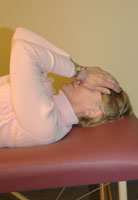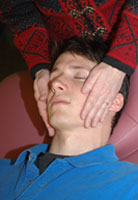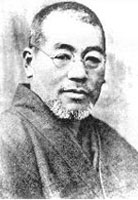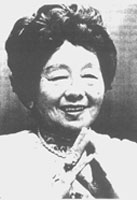
What is Reiki?
Reiki is a spiritual, vibrational healing practice used to promote balance throughout the human system. Reiki does not involve physical manipulation or the ingestion or application of any substances, but works with the subtle vibrational field thought to surround and penetrate the body. (Reiki is commonly translated from the Japanese as universal life energy.)
Reiki treatment is usually facilitated by light, non-manipulative touch to a clothed recipient. You can get Reiki treatments from a either a professional or a friend who has been trained, or you can learn to give yourself Reiki-treatment as a daily wellne ss practice.
ss practice.
People receiving Reiki often express a sense of connection to their own innate spirituality, or inner source of meaning. There is, however, no religious belief system attached to Reiki.
Reiki was originally developed as a practice forself-care, and students were encouraged to give treatment to and receive treatment from others. The practice can be easily learned by anyone who is interested, regardless of age (children through seniors) or condition of health.
Reiki treatment is usually facilitated by light, non-manipulative touch to a clothed recipient. You can get Reiki treatments from a either a professional or a friend who has been trained, or you can learn to give yourself Reiki-treatment as a daily wellne
 ss practice.
ss practice.People receiving Reiki often express a sense of connection to their own innate spirituality, or inner source of meaning. There is, however, no religious belief system attached to Reiki.
Reiki was originally developed as a practice forself-care, and students were encouraged to give treatment to and receive treatment from others. The practice can be easily learned by anyone who is interested, regardless of age (children through seniors) or condition of health.
Some people practice or receive Reiki to strengthen their wellness; others use it to help cope with symptoms, such as pain or fatigue, or to support their medical care, even in the case of chronic illness or at the end-of-life. According to a national survey published in 2007, 1.2 million adults and 161,000 children received one or more sessions of an energy therapy such as Reiki in the previous year.
How does it relate to other complementary therapies?
The National Center for Complementary and Integrative Health (NCCIH) describes Reiki as a complementary and alternative medicine practice that uses putative (yet to be measured) energy fields, or biofields, to affect health. Energy biofield therapies "generally reflect the concept that human beings are infused with subtle forms of energy," which are believe to surround and interpenetrate human form. Energy therapies, such as therapeutic touch and Healing Touch, are believed to balance these subtle energy fields.
Some Reiki practitioners find that Reiki is different from other energy therapies and is actually closer tomeditation. For example, while most energy therapies use techniques to assess the recipient's biofield and make specific corrections, Reiki practitioners do not diagnose and do not deliberately reorganize the biofield.
Some Reiki practitioners find that Reiki is different from other energy therapies and is actually closer tomeditation. For example, while most energy therapies use techniques to assess the recipient's biofield and make specific corrections, Reiki practitioners do not diagnose and do not deliberately reorganize the biofield.

Reiki practice is extremely passive. The Reiki practitioner's hands are still for most of the treatment, moving only to change hand placements. The Reiki practitioner is neutral, making no attempt to fix the recipient or to change the biofield. Additionally, the practitioner does not in any way control Reiki energy; she/he merely rests her hands lightly on the body (or just above the body if needed, for example, in the presence of an open wound or burn).
Reiki energy in the practitioner's hands arises spontaneously in response to the individual recipient's need for balance at that particular time. In this way, each Reiki treatment is automatically customized to the immediate need of that particular recipient, even though the practitioner may use the same sequence of hand placements for each treatment.
Reiki is optimally given in a full treatment format but can also be administered in abbreviated treatments to a specific area or areas of the body. In urgent situations, even moments of Reiki touch can be soothing.
Reiki is optimally given in a full treatment format but can also be administered in abbreviated treatments to a specific area or areas of the body. In urgent situations, even moments of Reiki touch can be soothing.
Where does it come from?
 Reiki, as it is practiced in the U.S. today, dates back to the teachings of Mikao Usui in Japan in the early 1920's. Usui was a lifelong spiritual aspirant, a lay monk with a wife and two children. In Usui's time, various lineages of Buddhist, Taoist, and Shinto practices coexisted as the dominant themes in Japanese spirituality and culture.
Reiki, as it is practiced in the U.S. today, dates back to the teachings of Mikao Usui in Japan in the early 1920's. Usui was a lifelong spiritual aspirant, a lay monk with a wife and two children. In Usui's time, various lineages of Buddhist, Taoist, and Shinto practices coexisted as the dominant themes in Japanese spirituality and culture.Usui's intense spiritual practices culminated in a profound revelation that led to the practice now commonly called Reiki. This realization most likely occurred in 1922.
Usui traveled widely in Japan during the last four years of his life, offering his spiritual teachings to more than 2,000 beginning students, but training only 16 as Reiki masters. One of his master students, Chujiro Hayashi, was a retired naval officer. Hayashi worked with Usui to excerpt the healing practices from Usui's larger body of teachings so that they could be more widely disseminated.
 With Usui's blessings, Hayashi opened a Reiki clinic in Tokyo where 16 practitioners gave treatment in pairs. Hawayo Takata, a first generation Japanese-American, came to Hayashi's clinic for relief from a number of medical conditions, including asthma. Months of treatment restored Takata's health, and she became a devoted student.
With Usui's blessings, Hayashi opened a Reiki clinic in Tokyo where 16 practitioners gave treatment in pairs. Hawayo Takata, a first generation Japanese-American, came to Hayashi's clinic for relief from a number of medical conditions, including asthma. Months of treatment restored Takata's health, and she became a devoted student.With Hayashi's active guidance and support, Takata brought Reiki to Hawaii in 1937 and eventually to the US mainland. Takata practiced and taught Reiki for 40 years before she began training Reiki masters (practitioners empowered to teach others). Since Takata's death in December 1980, her 22 Reiki masters have spread her teachings. Reiki has become very popular and is now practiced around the world, although not usually in the traditional form Takata taught.
No comments:
Post a Comment